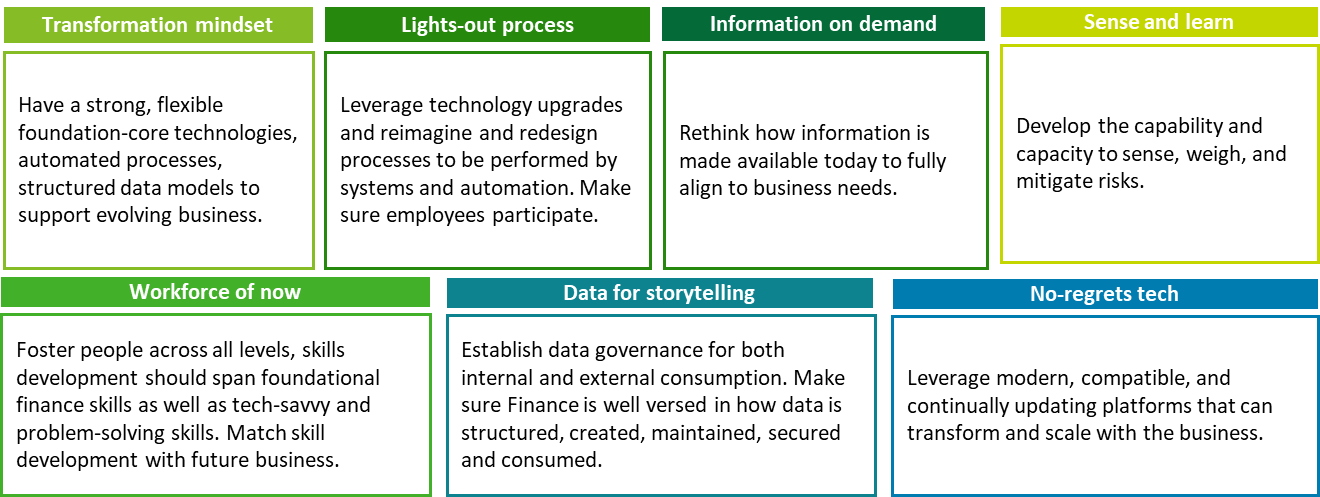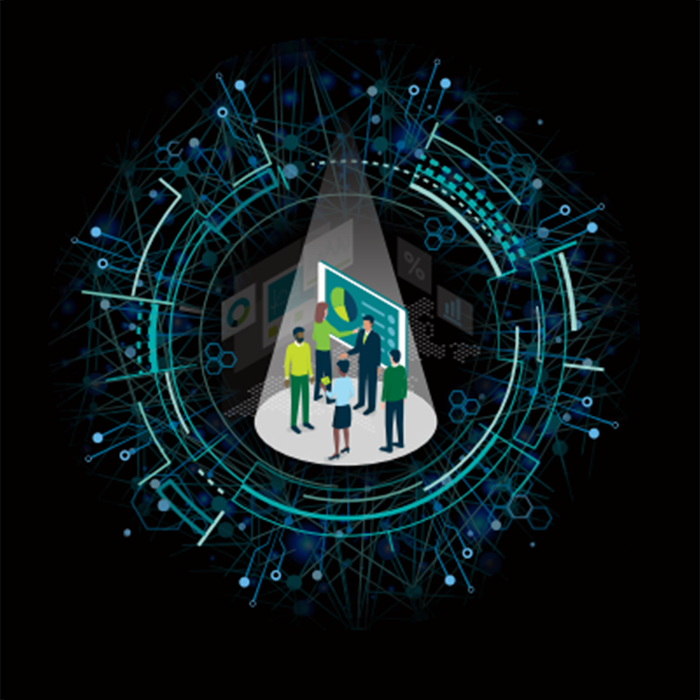Article

2022 Q4 Deloitte CFO Express
Issue No. 8
Published: 5 December 2022
Explore Content
- Play this episode
- Big Decision looming on the horizon
- Key takeaways from the Report on the 20th National Congress of the Communist Party of China
- Investments and M&A transactions in the New Energy industry in the H1 2022
- Global Digital Risk Survey 2022
- Insights and Outlook on Green Finance for Listed Chinese Banks (2022)
- Crunch time series: The future of Finance is dynamic
- Tax Transformation Trends Series- Technology in Focus
- Crunch Times series: The finance workforce of now
The release of the Q3 GDP data has shown that Chinese economy is recovering with a YoY growth rate of 3.9%. The recent 20th National Congress clarified the strategic suggestions of key development areas for the next five and 10 years. High-quality development is the key to China's modernization. Among others, the word 'security' was mentioned about 90 times in the key takeaways from the Report on the 20th National Congress, and the strategic importance of the security of food, energy, and industrial chain is further elevated. Unprecedented shock brought by pandemic, and industrial upgrade and transformation, has accelerated digitalization, ensuring reliability of digital technology and stability of supply chain has become main challenges for many businesses. Businesses need to continue to improve their risk prediction and management ability to enhance agility and efficiency, while embracing digitalization, so as to maintain trust in the brand, and keep confidence in clients and employees.
The issue of CFO Express provides insights on both macro and industry perspectives about market dynamics and the disruptions that organizations currently face. It includes the key takeaways from the report on the 20th National Congress of the Communist Party of China, and investment and M&A transactions in the new energy industry as well as insights and outlook on green finance for listed Chinese banks. It also covers discussions on operational improvement, related to dynamic finance, tax transformation, finance workforce and findings from global digital risk survey. We hope finance executives and their colleagues find these excerpts instructive.
Chief Economist’s View |
|
Trends and Outlook |
|
Expertise and Practice |
|
Talent and development |
 Chief Economist's View
Chief Economist's View
Big Decision looming on the horizon
Deloitte Chief Economist, Sitao Xu, shares his perspectives on China's economic outlook for the fourth quarter of 2022. His main takeaways are:
- The release of the Q3 GDP data has shown that the Chinese economy is recovering and may grow up to 3.9% YoY. Q4 is likely to see improvements on GDP growth assuming policy priorities pivot towards economic rebound by undertaking major actions to stabilize property market and to boost consumer confidence, and 2022 annual GDP growth could reach 3.2%-3.5%.
- As the Fed continues monetary tightening, the widening of interest rate differentials will bring downward pressure on the RMB. We expect that the Fed might be getting closer to the end of the tightening cycle. As China continues to run a considerable current account surplus, monetary policy space can be expanded by enhancing interest rate flexibility.
- The government has introduced a series of measures to boost the real estate market, but previous measures such as lower mortgage rates and tax rebates have brought limited stimulus; the recent fluctuations in both stock market and international bond have indicated that the real estate sector may face bigger financial risks, which will negatively impact consumption if not properly addressed. We suggest that as a next step, policy priorities could focus on targeted stimulus to the real estate market.

More information: Big Decision looming on the horizon
Key takeaways from the Report on the 20th National Congress of the Communist Party of China
The Report on the 20th National Congress is a programmatic report covering all aspects of national development and which indicates the strategic suggestions for the next five and 10 years. Based on the development goals mentioned in the 19th National Congress report and the 14th Five-Year Plan, the report further clarifies the path towards modernization, while also incorporating the country’s vision for 2035 whereby the establishment of a "dual circulation" development pattern will be accelerated. This entails that the domestic economic cycle will play a leading role, while the international economic cycle will act as a supplement. Compared to the report on the 19th National Congress, the report on the 20th National Congress added three chapters around development initiatives, including "Invigorating China through Science and Education and Development a Strong Workforce for the Modernization Drive", "Exercising Law-Based Governance on All Fronts and Advancing the Rule of Law in China", and "Modernizing China's National Security System and Capacity and Safeguarding National Security and Social Stability". These are presented each as separate sections, reflecting the importance of science and education, the legal system and safety. We provide excerpts on four key topics from the report below:
The real economy is the priority in modernizing the industrial system. We must continue to focus on the real economy in pursuing economic growth, and pay greater focus within the manufacturing industry to the foundations of reengineering projects, research projects around major technologies and equipment, as well as specialized and sophisticated SME. At the same time, we will continue to promote the further integration of modern services with advanced manufacturing and modern agriculture. In addition, we will accelerate the development of the digital economy, further integrate it with the real economy, and build internationally competitive digital industry clusters.
Emphasis on the security of development. We will ensure the security of food, energy, resources as well as key industrial and supply chains. Specifically, ensuring that China's total area of farmland does not fall below the redline of 120 million hectares and that the country’s food supply remains firmly in its own hands. There will also be greater focus on promoting the new energy strategy in order to reduce the dependence on foreign oil and natural gas, while also solving bottlenecks such as chip and other core technologies, so as to help the next-gen IT industry build an independent and controllable industrial chain.
Promoting green development and harmony between humanity and nature. Promoting the low-carbon transition and building a new energy system will be the government’s priorities, and we will advance initiatives in a well-planned manner that is based on China's energy and resource endowment. Fossil fuel energy will be used in a cleaner and more efficient way, and greater efforts will be made to explore the development of new energies. The integration of digital technology with the power grid, energy storage and energy replenishment facilities will give rise to new models of development and will provide some new cooperation opportunities and solutions.
Promoting high-quality opening up to turn China into a force in global trade. We will leverage the strengths of China's enormous market to attract global resources and production factors, as well as to steadily expand institutional opening up with regards to rules, regulations, management, and standards. We have worked to build a global-oriented network of high-standard free trade areas, and focus on upgrading and optimizing trade in goods, innovative trade in services, and the development of digital trade.

More information: Key takeaways from the Report on the 20th National Congress of the Communist Party of China (Chinese version only)
 Trends and Outlook
Trends and Outlook
Investment and M&A transactions in the New Energy industry in the H1 2022
Investments and M&A transactions were active in New Energy industry in H1 2022 and up to 77.6% YoY, with the power battery sector setting a record high, contributing to more than half of the deal value. We've seen a large proportion of PE/VC investors, and higher involvement from private enterprises with the number of transactions climbing from 31 in the H1 2020 to 90 in the H1 2022. In general, domestic transactions dominated the market, and outbound deals continue to decline as a result of unstable external environment. We have analysed the activities in each sector of the New Energy industry:
- Power battery has the highest number of deals in the New Energy industry, with EV, solid-state battery (SSB), and lithium metal battery (LMB) as popular areas. Along with the evolvement of high-energy solid battery, new areas such as manganese cathode material, non-cobalt cathode material, and silicon anode material have gained attention from investors.
- Deals in relation to clean-energy generation continue to grow, domestic deals have the highest percentage, and most investors are state-owned enterprises. Power stations contributed a large proportion of deal volumes, deals related to photovoltaic power station and wind power station are on the rise. In addition, biomass energy is gradually become a new hotspot in the investment area of new energy power generation.
- Transactions in midstream of photovoltaic industry are under spotlight, prior to 2022 investors are more focused on areas such as battery, battery cell and battery components, and have now expanded into multiple investment areas. Technology upgrade will continue to be an investment priority, for example, heterojunction cell is gaining traction.
- The release of the Medium to Long-term Plan of the Hydrogen Energy Industry Development (2021-2035) has stated the importance of hydrogen development, driving increases in investments and M&A transactions in 2022. Capital movement quickly follows suit, and main investment areas in hydrogen development are fuel cell, power stack, membrane electrode assembly and proton exchange membrane.
- Stored energy becomes a necessary condition for solving clean energy instability, investment and M&A transactions has a significant increase since H1 2022, the main areas are battery energy storage system and related materials. Flow battery has emerged as the next generation technology in 2022, with two competing technologies of iron-chromium flow battery and vanadium redox flow battery, both of which are currently in the early stages of industrialization.

More information:Investment and M&A transactions in the New Energy industry in the H1 2022 (Chinese version only)
Global Digital Risk Survey 2022
As digital transformation accelerates, the question of ethics has become even more prevalent, making the safety, security and sustainability of those technologies even more critical. The survey found that just 22% of consumers declare themselves "highly confident" about the use of digital technologies compared to 40% among leaders, leaving a substantial gap between consumer and business leaders. Deloitte has interviewed consumers and business leaders from financial services, public sector, consumer products and other industries, to explore the topic of how to build digital confidence among customers and businesses.
More control over digital technology and regulatory intervention help enhance users' confidence. The survey results point to the best scenarios for digital technology, which is providing recommendations and improving process efficiency. However, human actors should have more control and transparency over their final decisions and outcomes, for example, having more authority to override or cancel digital process. And more than half of consumers (55%) would feel more confident about using digital technologies if regulators had more authority and oversight.
The most adverse digital incidents are related to interaction between human and technology instead of the technology itself. The most prevalent issue was customer service being unable to solve problems, with 23% of respondents reporting such experience, so lack of quality customer service is more worrying than technology failure itself. Digital transformation is not just about technology, but also about longer-term considerations on optimizing people and processes under that context.
Business leaders fail to anticipate or mitigate digital risks appropriately. Only 15% of business leaders realize the risk of losing customers as a result of digital incidents on a timely basis, and more than a third of business leaders acknowledge that the digital risk management abilities of their businesses need to improve, with the scope of responsibilities yet to be defined. Organizations should regard digital risk as a new and separate risk category, and take a systematic approach to managing all risks associated with digitization.

More information: Global Digital Risk Survey 2022
Insights and Outlook on Green Finance for Listed Chinese Banks
Since the concept of "establishing a green finance system" first proposed in 2015, Chinese green finance system has been under gradual construction, with standards, environmental information disclosure and evaluation clearly stated, while formulating local policies on regional development and climate investment, and expanding monetary policy tools to support green finance development. Deloitte has taken 59 listed banks in China as a sample, including large state-owned bank, joint-stock bank, city commercial bank and rural commercial bank, for the purpose of analysing existing issues of developing green finance business. Our study also includes recommendations in strategic planning, organizational structure, regulation, execution, capacity building and products & services, to help banks to build a systematic green finance management system.
The scale of green credit continues to expand, the degrees of environmental information disclosure vary among different types of banks. The scale of green credit business for large state-owned banks has grown steadily, with a 30% annual growth rate, and the linked credit products are catching up to international standards. Growth among small and medium-sized banks were also substantial, for example, growth rate for joint-stock banks was 94% in 2022, and they have fully leveraged local policies to develop green finance products. Compared with small and medium-sized banks, large state-owned banks have higher completion related to environmental information disclosure, with 50% of large state-owned banks disclosing main categories. The percentage of environmental information disclosure by joint-stock banks has increased from 30% to 50% in the past three years, while the percentage by urban and rural commercial banks is between 10% and 20%, and has shown tendency to rise.
Commercial banks have actively participated in the green bond market through issuance, investment and underwriting. As of August 2022, the total amount of issuance by listed banks exceeded RMB 190 billion. The main venue for green bond issuance is the inter-bank market, contributing to 50% of green bonds in circulation, and commercial banks are the main participants. For future product innovation, commercial banks can consider derivative green bond products related to sustainable development.
The main participants for green investments are subsidiaries or group companies of commercial banks. Large state-owned banks leverage their wider range of licenses and are involved in a variety of activities in green investment. Nearly 40% of joint-stock banks participate in green investment mainly through leasing, wealth management, investment companies and funds, while participation of city and rural commercial banks are less than 20% and close to zero respectively.
Joint-stock banks actively participate and develop a variety of green service solutions. The gap between banks in green services is relatively small, joint-stock banks and small and medium-sized banks are the most active participants and have made some progress in green index and carbon market. In the future, small and medium-sized banks are expected to make breakthroughs in developing service solutions and playing in fund custody, payment and intermediary services.

More information: Green Finance Insights and Outlook for Listed Chinese Banks (Chinese version only)
 Expertise and Practice
Expertise and Practice
Crunch time series for CFOs: The future of Finance is Dynamic
The pace of quick changes - internal, social, economy and geopolitical changes have forced CFOs to consider how to transform finance from function to dynamic capability that adapts quickly for the future. From what we've seen, not many finance functions out there can move as fast as they need to. Dynamic finance is a new way of operating that builds agility, resilience and automated process, to help finance improve stability and risk response, and turn challenges into opportunities. We have defined the following principles to help finance leaders to adapt their organizations to thrive amid that change.
Graph: The principles of Dynamic Finance

To better establish and practice dynamic finance, CFOs should have a clear sense of which principles should first be addressed, and continue to break down barriers such as functional silos, technology costs and internal inconsistent drivers. We've also analysed three scenarios - business model transformation, divestiture and market shock - and illustrated specific initiatives and how a dynamic finance capability will help organizations adapt quickly in an uncertain environment.
- Modern core and edge technologies, clearly defined data model, and organization-wide digital risk methodology are the most critical initiatives for supporting the launch of the new business segment when talking about the business model transformation, helping organizations to adapt new process and output with minimal investment, and to allow design and implement new reporting within risks under control.
- Divestitures require organizations to have scalable financial tools sets, as well as coordinated enterprise data strategy and tools to support continuous, on-demand analytics within minimal resource investment. Talent and delivery model shall be designed based on the needs of the business, so that the finance team has experience working across functions and domains.
- Dealing with market shock requires the finance team to provide timely insights, technology, process, talent, and data. The finance team shall have enhanced end-to-end processes, and leverage tech-enabled liquidity management and forecasting capabilities to improve visibility and control over cash, so as to rapidly assess profitability and make decisions accordingly.

More information: Crunch time series for CFOs-The future of Finance
is Dynamic
Tax Transformation Trend Series- Technology in Focus
The OECD's Pillars 1 and 2 agreements, and tax authorities' accelerating move toward digital tax administrations are giving rise to challenges for companies' internal systems and processes. According to our survey, 70% of respondents expect that tax authorities will have more direct access to their IT systems within 3 years. In the context of tax transformation, leveraging the NextGen ERP and coping with evolving digital tax administration are becoming priorities for businesses. Nearly half of the respondents say they will take a proactive and expansive approach to technology upgrade related to tax, including redesigning their entire digital architecture.
NextGen ERP helps data access for tax transparency. Tax leaders are leveraging NextGen ERP to work with finance team, to gain access to tax-sensitized data via revamped, standardized process and integrated systems, and help businesses to build data houses in order. Most respondents (86%) are in the process of implementing a next-generation cloud-based ERP system, and those companies deploying a modernized ERP system already see benefits that stretch beyond compliance and reporting. For example, 60% of this group describe their abilities to conduct sophisticated scenario modelling to be very strong relating to the OECD Pillars 1 and 2 changes.
Artificial Intelligence (AI) involvement accelerates in tax operations. The tax leaders in our survey have leveraged AI and Machine Learning (ML) to help transform their tax operations, 75% of respondents say their teams are likely to make sure of such capabilities in the next two years in areas such as classification of tax data, real-time reporting adjustment and data quality improvement. But data governance issue, internal resistance to change, and shortage of skilled talent will hinder the development of AI and ML applications.
Blended operational models will be the norm for the foreseeable future. 80% of respondents agree their function is evolving toward a model which combines outsourcing, in-sourcing, and co-sourcing of tax operations. While a majority in Europe and North America will outsource digital tax administration, most businesses in Asia Pacific plan to manage it in-house. 74% of respondents intend to eventually bring at least some operations back in-house once they have developed the internal capabilities to manage them effectively.

More information: Tax Transformation Trend Series- Technology in Focus
 Talent and development
Talent and development
Crunch time series: The finance workforce of now
In the past few years of unprecedented change, from social unrest to a global pandemic, employees have heightened their expectations of their jobs, such as flexibility, career growth and opportunity, compensation and recognition. This is an opportunity for organizations to reimagine their Finance function as a dynamic capability that enables the organizations to do more, such as redesigning the work by applying technology solutions, achieving new outcomes and new value; unleashing and engaging workforce in new ways of working; and reinforcing inclusive and equitable culture in the organization.
Finance as storyteller at all levels to different stakeholders inside and outside the organization. The pandemic accelerated the need for Finance to be a key pillar of an organization's strategic decision-making. The Finance team is responsible for identifying trends and explaining implications to workforce, for example, telling the story of an organization's future, and showing what can happen when humans and technology work together combining their respective strengths.
Technology as supplement to help humans do more strategic work that adds value. Rather than forcing workers to fit the needs of the technology, technology should augment the work that only humans can do. Finance leaders need to first map out the future work that needs to be done, and continue to think about the human skills needed to level up the work.
Flexible is key and hybrid work will stay for the long term. More than 70% of workers want continued flexibility and to maintain remote work options. We anticipate most organizations will offer an ecosystem of hybrid work. Finance leaders should also consider factors such as flexible compensation and benefits strategy, talent life cycle and change management when designing workplace strategies.

More information: Crunch times- The finance workforce of now
Contact us
If you need any further information, please feel free to reach out to your Deloitte contact person, or reach out to us via the following contact details.
Norman Sze
Vice Chair
Deloitte China
Phone: +86 10 8512 5888
Email: normansze@deloitte.com.cn
Maggie Yang
Partner
Finance & Performance
Deloitte Consulting
Phone: +86 10 8520 7822
Email: megyang@deloitte.com.cn
Bo Sun
Senior Manager
The CXO Program
Deloitte China
Phone: +86 10 8512 4866
Email: bsun@deloitte.com.cn
Explore Content
- Play this episode
- Big Decision looming on the horizon
- Key takeaways from the Report on the 20th National Congress of the Communist Party of China
- Investments and M&A transactions in the New Energy industry in the H1 2022
- Global Digital Risk Survey 2022
- Insights and Outlook on Green Finance for Listed Chinese Banks (2022)
- Crunch time series: The future of Finance is dynamic
- Tax Transformation Trends Series- Technology in Focus
- Crunch Times series: The finance workforce of now
